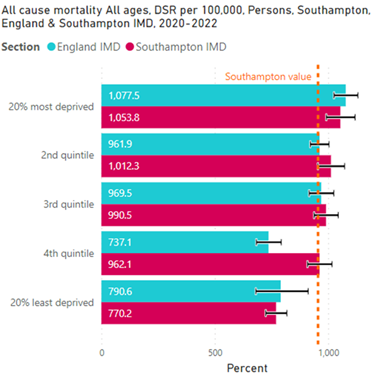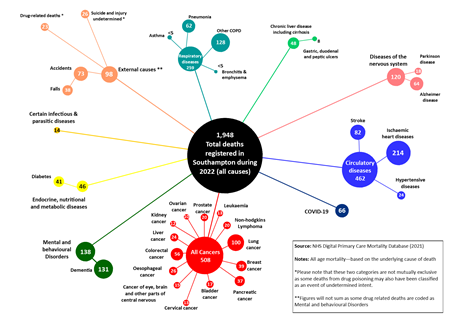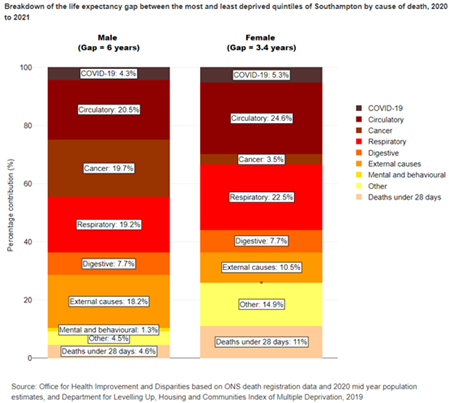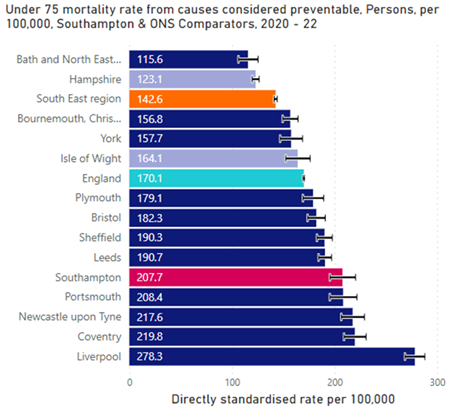
Mortality
 Mortality overview
Mortality overview
Assessing the number and rate of deaths (or mortality) in any population is important in understanding and monitoring the health status of a whole community. Understanding the underlying causes of mortality, the prevalence and trends in premature (deaths before 75 years of age) and preventable mortality (causes of death that can be mainly avoided through effective public health and primary prevention interventions) are particularly important, with preventable mortality being a priority area in the Southampton 2017-25 Health and Wellbeing Strategy.
In the UK, deaths must be reported to the Local Registration Service, in partnership with the General Register Office (GRO). This is a legal requirement as set out in the Births and Deaths Registration Act (1836). The coding used for cause of death is carried out according to the World Health Organization (WHO) International Classification of Diseases (ICD-10) and internationally agreed rules, allowing for international comparisons.
Numbers of deaths represent the number of registered deaths in a population but, because there can be registration delays including those deaths requiring a coroner’s verdict, deaths by date of registration may include deaths that occurred months or even years earlier. Deaths for Southampton include resident deaths that occur outside Southampton.
Benchmarking and trends data uses ONS Mid-Year Estimate population to calculate rates. For sub-city analysis, Small Area Population Forecasts (SAPF) from Hampshire County Council is used to calculate rates. Across these analyses averages for Southampton as whole will differ as a result. Also Ward and locality totals for the city values may not match deprivation quintile city totals due to the affect of 2023 electoral ward boundary changes.
More information is available in the mortality dashboard available below and in the resources section.
Mortality in Southampton
In 2022, there were 1,948 deaths registered in Southampton. Trend and benchmarking data is available for 2020-22 where mortality from all causes in Southampton was 6,005 deaths. This is a directly age standardised rate (DSR) of 1,090 deaths per 100,000 population, which is significantly worse than the England average of 1,013 per 100,000 population. Southampton is mid ranked with the 6th highest mortality rate amongst its Office for National Statistics (ONS) comparator group (12 local authorities).
 Large differences are seen between males and females. The Southampton DSR of 1,331 per 100,000 population for males, which is significantly worse than the England rate of 1,196 DSR per 100,000 population and 5th highest among our ONS comparator group. For females, in Southampton, the DSR was 900 per 100,000 population, which is significantly worse than the England average (864 DSR per 100,000 population) and 8th highest among our ONS comparator group.
Large differences are seen between males and females. The Southampton DSR of 1,331 per 100,000 population for males, which is significantly worse than the England rate of 1,196 DSR per 100,000 population and 5th highest among our ONS comparator group. For females, in Southampton, the DSR was 900 per 100,000 population, which is significantly worse than the England average (864 DSR per 100,000 population) and 8th highest among our ONS comparator group.
Between 2001-03 and 2009-11, the mortality rate had been decreasing slightly faster in Southampton than in England. However, since 2009-11, the England rate has continued to decrease whilst the Southampton rate has increased. In both England and in Southampton, a rise was seen in mortality from 2017-19 to 2020-22. This is likely due to the start of the COVID-19 pandemic with the trend expected to continue as further data is released for the COVID-19 pandemic period. More information on the impact of COVID-19 can be found in the COVID-19 impact assessment.
Mortality varies at a sub-city level for 2020-22 from a DSR of 590 per 100,000 SAPF population in Bargate ward to 1,305 DSR per 100,000 SAPF population in Peartree ward, with the city average of 969 DSR per 100,000 SAPF population. East locality has the highest DSR of 993 per 100,000 population with North & Central the lowest at 951 DSR per 100,000 population. The following sections illustrate how mortality varies by age and deprivation.
More information is available in the mortality dashboard available below and in the resources section.
Mortality by age

In Southampton, in 2020-22 (pooled), the number of stillbirths (those infants that died in the womb after having survived through at least the first 24 weeks of pregnancy) was 2.9 per 1,000 births, which is lower, but not significantly, to the national average (3.9 per 1,000 births). Southampton is continuing to decrease since 2018-20 and is the 2nd lowest among comparators.
The neonatal mortality rate (deaths under 28 days) for Southampton, in the same period, was 3.1 per 1,000 births, which is statistically similar to the England average (2.9 per 1,000 births) and the 4th highest among ONS comparators. The post-neonatal mortality rate (deaths between 28 days and 1 year) for Southampton, for 2020-22, was a crude rate per 1,000 of 0.7 per 1,000 births, which is lower than the England rate (1.1 per 1,000 births), although not statistically significantly so. This is the 4th lowest among the ONS comparator group.
Infant mortality (deaths under 1 year of age) in Southampton has increased overall from 2.8 per 1,000 births in 2012-14 to 4.9 per 1,000 births in 2019-21. In comparison, the England average has remained consistent between 3.9 and 4.0 per 1,000 births over the same period. Since 2014-16, the infant mortality rate in Southampton is higher than the England average and been one of the top 5 ONS comparators. However, for 2020-22 period, Southampton decreased to 3.9 per 1,000 births, the same rate as England.
The all cause child mortality rate (deaths of a child between the ages of 1 and 17 years) in Southampton in 2020-22 was 10.4 DSR per 100,000 persons, which is statistically similar to the England average (10.4 per DSR per 100,000 persons). Southampton is mid-rank among its ONS comparator group. The England rate has decreased at a faster rate than in Southampton since 2010-12.
Hospitals remain the most common place of death in 2022 across all age groups (40.6% of all deaths in Southampton and 43.4% in England). In 2020, for those people aged 85 and over, the common place of deaths was in care homes (37.5%), likely due to the pandemic, however in 2022 the most common place of death was in hospitals (36.4%), the same as before the pandemic. There has been a significant increase in deaths occurring at home since 2013 from 15.0% to 25.5%. Southampton has always been higher than England and is increasing at a faster rate.
More information is available in the mortality dashboard available below and in the resources section.
Mortality by deprivation
 Within the city, mortality rates for England and Southampton deprivation quintiles are statistically significantly higher and around 1.4 times higher in the 20% most deprived areas compared to the 20% least deprived areas for persons, males and females in 2020-22.
Within the city, mortality rates for England and Southampton deprivation quintiles are statistically significantly higher and around 1.4 times higher in the 20% most deprived areas compared to the 20% least deprived areas for persons, males and females in 2020-22.
Under 75 mortality by England deprivation quintiles is 1.7 times higher in the 20% most deprived areas in Southampton compared to the 20% least deprived (527 compared to 305 DSR per 100,000 population).
For males this increases to a difference of 1.7 times higher (641 compared to 367 DSR per 100,000 population), whilst for females the difference is 1.7 times higher (419 compared to 239 DSR per 100,000 population).
More information is available in the mortality dashboard available below and in the resources section.
Underlying causes of mortality
 The underlying cause of death is most often used to understand more about patterns and trends in mortality among a particular population. The underlying cause of death is defined by the World Health Organization as “the disease or injury which initiated the train of morbid events leading directly to death, or the circumstances of the accident or violence which produced the fatal injury”.
The underlying cause of death is most often used to understand more about patterns and trends in mortality among a particular population. The underlying cause of death is defined by the World Health Organization as “the disease or injury which initiated the train of morbid events leading directly to death, or the circumstances of the accident or violence which produced the fatal injury”.
When looking at deaths grouped by underlying cause in Southampton for 2022 it was found that:
- The three main causes were:
- Cancer - 508 deaths (26.1%)
- Circulatory diseases – 462 deaths (23.7%)
- Respiratory diseases - 259 deaths (13.3%)
- Lung cancer accounted for 1 in 20 of all deaths and 1 in 5 cancer deaths (100 deaths)
- 46.3% of circulatory disease deaths were caused by Ischaemic heart diseases, also known as coronary heart disease (214 deaths)
- 49.4% of all respiratory disease deaths were attributed to other COPD (128 deaths)
- COVID-19 was responsible for 3.4% deaths in 2022, a 72.2%, decrease from 2021 deaths (237 COVID deaths)
The provisional 2023 underlying cause of deaths in Southampton can be found on the Life Expectancy and Mortality dashboard, available below.
 The Office for Health Improvement and Disparities (OHID) have produced an inequalities segment tool which shows the relative contribution that nine broad causes of death have on the gap between life expectancy for Southampton and that for England for the 2020 to 2021 period. Circulatory disease (20.5%), cancer (19.7%) and respiratory (19.2%) deaths are the largest groups contributing to the gap in male life expectancy compared to England. On closer inspection, the two largest causes are chronic lower respiratory disease followed by heart disease and other circulatory.
The Office for Health Improvement and Disparities (OHID) have produced an inequalities segment tool which shows the relative contribution that nine broad causes of death have on the gap between life expectancy for Southampton and that for England for the 2020 to 2021 period. Circulatory disease (20.5%), cancer (19.7%) and respiratory (19.2%) deaths are the largest groups contributing to the gap in male life expectancy compared to England. On closer inspection, the two largest causes are chronic lower respiratory disease followed by heart disease and other circulatory.
For females, circulatory disease (24.6%) is also the largest group contributing to the gap in female life expectancy compared to England, with respiratory diseases (22.5%), other causes (14.9%) and external causes (10.5%) also contributing. Cancer only contributed 3.5% to the gap for females, unlike for males where it was over 5 times higher. More detailed analysis shows the single largest cause of the gap in female life expectancy is chronic lower respiratory diseases followed by other and lung cancer. COVID-19 contributed 4.3% to the gap in male life expectancy and 5.3% to the gap for females.
More information is available in the mortality dashboard available below and in the resources section.
Preventable mortality
 Preventable mortality is defined as causes of death that can be mainly avoided through effective public health and primary prevention interventions (for example improvement of healthy behaviours to reduce the chance of disease).
Preventable mortality is defined as causes of death that can be mainly avoided through effective public health and primary prevention interventions (for example improvement of healthy behaviours to reduce the chance of disease).
In Southampton, under 75 mortality from causes considered preventable, was 208 DSR per 100,000 population in the period 2020-22 (pooled). This is statistically significantly worse than the England average (171 DSR per 100,000 population) and the 5th highest among our ONS comparators, behind Liverpool (280), Coventry (221), Newcastle upon Tyne (219) and Portsmouth (209). The rate for males and females is also significantly worse than the England average, with both rates the 5th highest amongst the ONS comparator group. For males in Southampton the rate is 274 DSR per 100,000, compared to 227 DSR per 100,000 population for England. For females the rate in Southampton is 143 DSR per 100,000 population compared to 119 DSR per 100,000 population for England.
The England trend has seen a decrease from 192 DSR per 100,000 persons in 2001-03 to 143 DSR per 100,000 persons in 2017-19 (pooled). Although the Southampton trend decreased at a similar rate to the England average, reaching a low of 179 DSR per 100,000 persons in 2014-16, the rate since then has increased once more to 186 DSR per 100,000 in 2017-19. After 2017-19, both England and Southampton’s rates have increased significantly – again likely due to the COVID-19 pandemic.
Within the city, there is substantial variation at a ward level. The preventable mortality rate for Thornhill is 252 DSR per 100,000 persons, which is 1.4 times higher as well as significantly higher than the city average and more than double than Bassett which has the lowest preventable mortality at 113 DSR per 100,000 for the period 2020-22 (pooled). There is also significant variation when looking at England deprivation. The preventable mortality of those living in the 20% most deprived areas (244 DSR per 100,000) is 3.2 times higher compared to the 20% least deprived (76 DSR per 100,000).
More information is available in the mortality dashboard available below and in the resources section.
Years of life lost
Not only is it important to consider the number of deaths from each underlying cause, but also the impact of each death. One way of measuring this is through calculating the number of years of life lost.
 Years of life lost (YLL) is a measure of the average time a person would have lived had they not died before the age of 75 years. This data helps measure the social and economic loss from dying younger and highlights the specific causes of death affecting younger people such as suicide and accidents.
Years of life lost (YLL) is a measure of the average time a person would have lived had they not died before the age of 75 years. This data helps measure the social and economic loss from dying younger and highlights the specific causes of death affecting younger people such as suicide and accidents.
Between 2020 and 2022, nearly 30,800 years of life were lost for Southampton residents aged under 75 years. During this period:
- Cancer (24.7% of YLL), circulatory diseases (18.4% of YLL) and respiratory diseases (4.8% of YLL) together accounted for over half of all years of life lost
- 7,617 years of life were lost due to cancer. The two highest contributing types of cancer were:
- Lung cancer; 1,411 years of life lost (18.5% of years lost to cancer deaths)
- Colorectal cancer; 862 years of life lost (11.3% of years lost to cancer deaths)
- 5,671 years of life were lost due to circulatory diseases. The highest contributing type was:
- Coronary heart disease (also known as ischemic heart disease); 2,852 years of life lost (50.3% of years lost to circulatory disease deaths)
- 2,128 (6.9%) years of life were lost due to suicide (and injury undetermined)
- 1,475 years of life were lost due to respiratory diseases of which 837 (56.7%) were other COPD
The provisional 2021-23 total years of life lost in Southampton can be found on the Life Expectancy and Mortality dashboard below.
More information on causes of mortality and years of life lost can be found in the resources section below, whilst analyses of the causes of mortality which contribute most to inequalities in life expectancy in Southampton can be seen in the life expectancy and health inequalities pages.
Resources
Life expectancy and mortality dashboard
The life expectancy and mortality dashboard present a range of data regarding life expectancy and mortality, to provide intelligence to help drive strategic decision making. Analysis includes benchmarking against statistical neighbours and trends over time for all indicators included. Some indicators include analysis at sub-city levels, by Southampton wards, primary care networks (PCNs) and deprivation quintiles.
Mortality bubble charts
Below are two bubble charts showing all cause mortality and the number of years of life lost. In these charts the size of the bubble is proportionate to the number of deaths and years of life lost.
OHID Fingertips - Mortality profile
The Mortality Profile brings together a selection of mortality indicators, including from other OHID data tools such as the Public Health Outcomes Framework, making it easier to assess outcomes across a range of causes of death.
OHID – Segment tool
This tool provides information on the causes of death and age groups that are driving inequalities in life expectancy at local area level. Targeting the causes of death which contribute most to the life expectancy gap should have the biggest impact on reducing inequalities.
ONS - Deaths broken down by age, sex, area and cause of death
Data on deaths broken down by age, sex, area and cause of death.
ONS - Child and infant mortality in England and Wales: 2022
Information on stillbirths, infant and childhood deaths occurring annually in England and Wales, and associated risk factors.
IHME – Global Burden of Disease (GBD)
The Global Burden of Disease (GBD) study provides a comprehensive picture of mortality and disability across countries, time, age, and sex. It quantifies health loss from hundreds of diseases, injuries, and risk factors, so that health systems can be improved and disparities eliminated.
GOV.UK - Palliative and end of life care
Information and resources for health and social care professionals to improve the quality of services and reduce inequalities in care.
Last updated: 23 September 2024